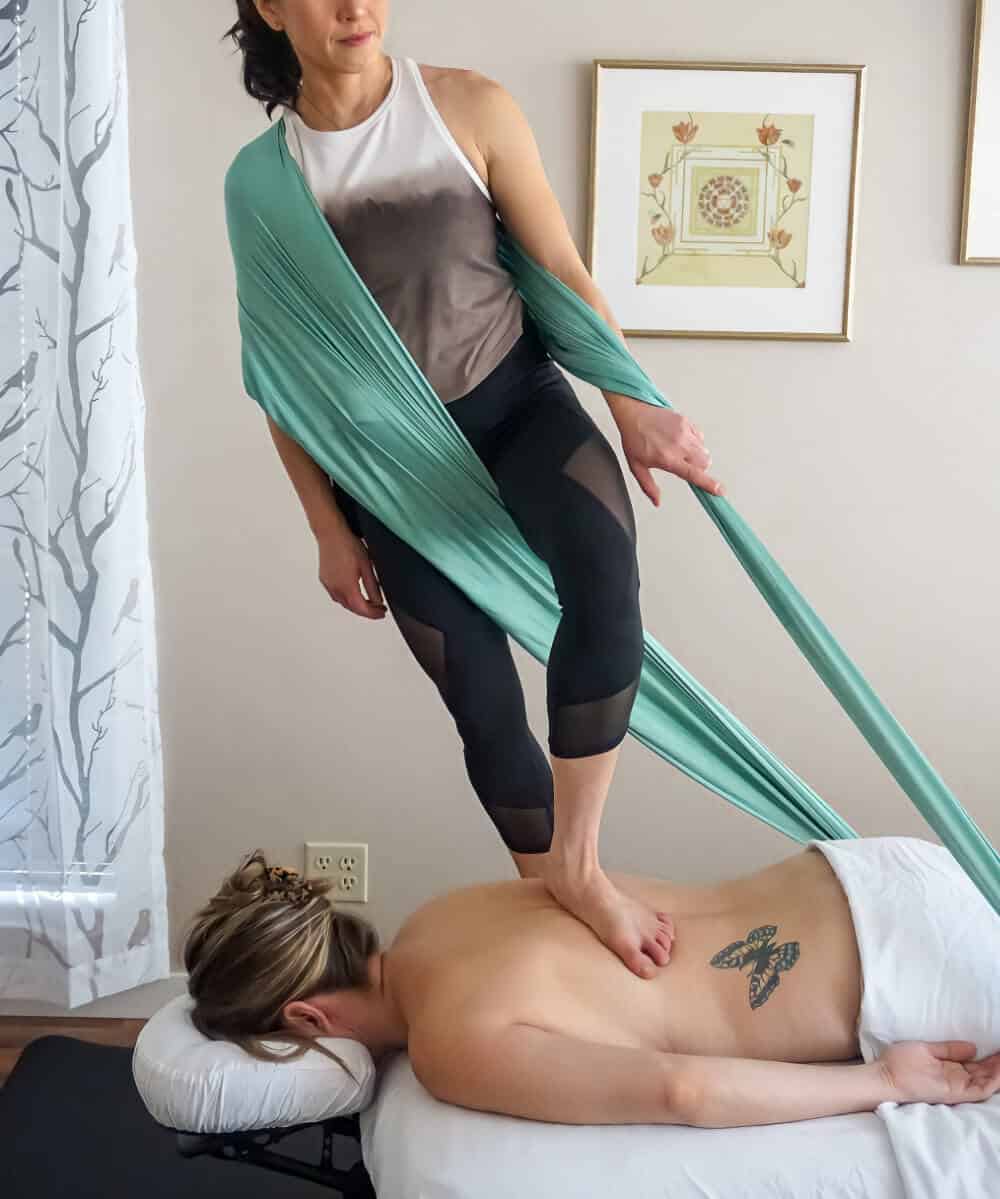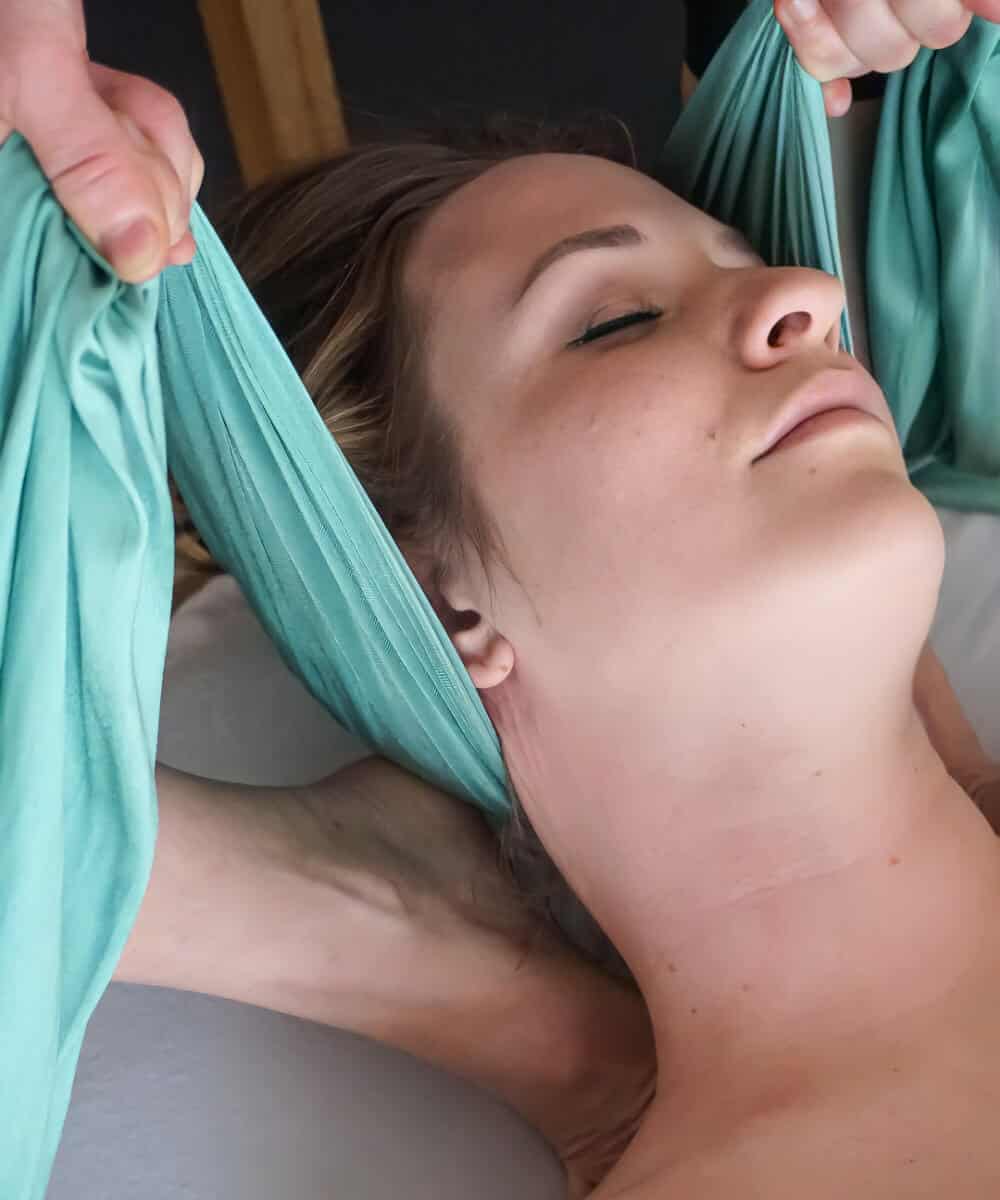Sarga Bodywork
Boise, ID
Slow, sustained deep tissue bodywork for myofascial release

A luxurious barefoot massage
Sarga is one of the lesser-known massage treatments in Boise but has quickly become a client favorite at Whole Being Massage. Especially for athletes or those who never feel like “regular” massages have deep enough pressure.
Unlike other massage techniques, Sarga is a barefoot method that applies deep, controlled strokes with a broad, rather than pointed, surface.
Using the feet allows a more relaxed and gradual application of pressure, and improves access to areas often difficult to treat (such as calves and forearms), as your practitioner is able to use their body weight and gravity to ease into just the right depth for you.
Sarga bodywork is truly unique in its potential to create structural change and healing in the body while deeply soothing the nervous system at the same time.
The power of touch and technique
This unique and effective myofascial therapy is all about straightening out twists and smoothing out kinks in your body’s fascia (connective tissue). Think of it like running a comb through tangled hair.
Clients describe the sensation as, “intensely relaxing,” and “the deepest pressure they’ve ever felt, but it doesn’t hurt at all!”
We invite you to experience the powerful benefits of Sarga, with a distinctive style of touch and technique that truly sets it apart.
Myo- What?
Sarga encourages myofascial technique over effleurage or traditional deep tissue techniques.
Myofascial work is characterized by slow, sustained, oblique, and high-tack contact with the aim of stimulating a stretch response in the fascia associated with muscle tissue. Making it effective to treat muscle pain, inflammation, and restriction.
- Relaxes contracted muscles
- Stimulates hydration and length in the tissue
- Improves blood and lymphatic circulation
The prefix “myo” refers to muscle tissue. Fascia is connective tissue that provides structural support in the body as it wraps around every single cell – connecting cells to organs, organs to organ systems, and interpenetrates every muscle.
The Sarga Strap
A fabric strap fastened to the massage table provides stability and is a signature in the setup of a Sarga massage.
The high degree of control and balance the Sarga Strap provides makes it possible to ease off pressure if needed and move at a slow pace – allowing your body to relax and receive deep, effective pressure.
SARGA, a word with meaning in both Spanish and Sanskrit, embodies the essence of this unique bodywork.
In Spanish, SARGA signifies a tapestry woven from diverse threads, mirroring how it weaves together various techniques and traditions into a colorful quilt of possibility.
In Sanskrit, SARGA represents the energy of creation, which takes form in our innovative tools and evolving approach to bodywork.
It’s both beautiful and appropriate that these metaphors are connected to the very fabric we hold in our hands for balance and support.
Sarga + Tensegrity
The Sarga bodywork method is a combination of bodywork techniques guided by tensegrity principles.
Tensegrity, coined by architect Buckminster Fuller, describes the synergistic relationship between ‘push’ and ‘pull,’ forming the core ideology of Sarga bodywork. In this concept, rigid elements, like bars or beams, are supported and aligned by continuously tensioned components, such as cables, to ensure structural integrity and resilience.
Biotensegrity applies these principles to biological structures, revealing the strength of muscles, bones, fascia, and connective tissues as they work together in a continuous network of tension and compression. One affects another.
Sarga Bodywork uniquely embodies these principles and contributes to a larger tensegrity framework involving the Sarga Strap, a massage table, and the connection between practitioner and their client.
It’s a dance of balance and harmony.
History Of Barefoot Bodywork
We celebrate the broad, nerve sensitive surfaces of our feet as perhaps our most effective and intelligent tools. As bodyworkers, the ability to perform massage with our feet opens up a whole new set of movement and treatment possibilities.
Using feet for massage is an ancient practice. Early techniques were often done without lotion or oil (for practical reasons) due to lack of structural support. In other words, without it, the practitioner might literally slide off their client’s body!
To cross this slippery slope, Keralite massage and Ashiatsu use overhead ropes or bars for balance.
Sarga offers a unique twist. Sarga is entirely portable and can be done on nearly any massage table. No overhead support required!

Sarga Bodywork
Pricing
VICTORIA
90 Minutes: $200
A massage unlike anything you’ve experienced before.
Experience Sarga’s gentle power to unleash healing and restore balance in your body.
“What a truly healing experience. I’ve had treatments from the top-rated in the business, which is hard to beat, and this was definitely one of the best EVER. What a restorative environment and intuitive touch. Couldn’t recommend them enough! Worth every penny. And if you like deep tissue, I would highly recommend giving the Sarga treatment a try.”
“I came in to try the Sarga Bodywork massage and it did not disappoint. This methodology of utilizing your feet and straps attached to the table provides a massage like no other. I left feeling amazing and felt even better the next day! Such a cool experience!”
Frequently Asked Questions
How Is Sarga Different Than A Deep Tissue Massage?
Sarga places a strong emphasis on myofascial and deep tissue work, provides a broader and more consistent pressure, and relies on the practitioner’s ability to glide smoothly across the body in continuous movement – using the Sarga Strap for stability.
Deep tissue massages also target deep muscle tissues, but typically involve more static pressure and less continuous movement – with more focused and pinpointed pressure, particularly when using elbows. Techniques and tools used may also vary from one practitioner to another.
Is A Sarga Bodywork Session Right For Me?
Although a very gentle, and deeply relaxing technique, Sarga is ideal for those who enjoy deep pressure.
Sarga is considered an advanced bodywork modality – generally recommended for those with some experience receiving massage and bodywork. Sarga may not be the right fit if this is your first massage or if you haven’t had bodywork in some time. We usually prefer to see you for at least one other massage session or do a phone consultation to determine if Sarga will be beneficial and appropriate for your needs.
That being said, just about everyone of all ages, fitness levels, and body types can benefit from Sarga once your body is ready.
Does Sarga Bodywork Hurt?
The unique design and use of the Sarga Strap allows your practitioner to easily adjust the pressure around more sensitive areas and provide a customized experience that’s right for you.
How Does Sarga Benefit Lymphatic Health?
Select massage therapists are also able to incorporate advanced lymphatic work into your Sarga session.
If you have specific lymphatic drainage concerns, we recommend booking a lymph drainage therapy session for a more targeted session focused on improving lymph health.
